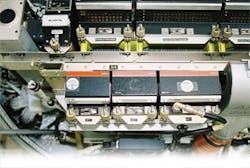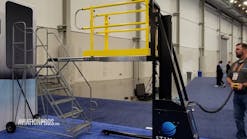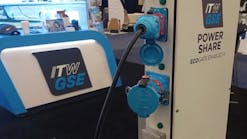The aviation industry has always been one that carried a certain mystique. After all it does breach many unknowns. Even after all these years we still refer to our most basic principle as "The Theory of Flight" and not "The Fact of Flight." Attacks from gremlins often stifle our most brilliant minds, and phenomenon such as Saint Elmo's fire is observed on a regular basis. I have even had comments from those many years my senior stating that aviation today is all smoke and mirrors. I know for a fact that this premise does carry some merit as anytime you see the smoke escape from one of these new fangled black boxes, the magic is over.
As our industry continues to evolve, electricity appears to be playing an ever more significant role in the operation of aircraft systems. It was not all that many years ago when mechanical devices and linkages were considered the standards to command the response from engines or even position flight controls. Today's aircraft use computers to regulate engine thrust as well as provide signals to position flight altering servoes. Does the use of this technology stimulate confidence? Consider the definition of electricity courtesy of the Houghton Mifflin Dictionary:The physical phenomena arising from the behavior of electrons and protons that is caused by the attraction of particles with opposite charges and the repulsion of particles with the same charge.
If that doesn't instill confidence, I don't know what would.
Magnetism is another topic associated with wizards and other mystical subjects and again the folks at Houghton Mifflin should be credited for their interpretation: the class of phenomena exhibited by a magnetic field.
What It Is
Electromagnetic induction is the production of an Electro Motive Force (EMF) in a conductor as a result of a changing magnetic field around the conductor. The concept was identified in 1831 by Michael Faraday and independently by Joseph Henry.
Variation in the field around an electrical conductor may be produced by relative motion between the conductor and the source of a magnetic field. This is the principle of an electric generator, by varying the strength of the field around the conductor a constant voltage can be maintained which compensates for variations in electrical load or even variations in the relative motion between the conductor and field.
Since a magnetic field is produced around a current-carrying conductor, such a field can be changed by changing the current. If the conductor in which an EMF is to be induced is part of an electric circuit, the induction can be caused by changing the current in that circuit; this is called self-induction. The induced EMF is always such that it opposes the change that gives rise to it, according to Lenz's law.
Changing the current in a given circuit can also induce an EMF in another nearby circuit, one that is unconnected with the original. This type of electromagnetic induction is called mutual induction and is the basis of the transformer plus a common cause of anomalies in aircraft systems. Electrostatic induction results when an unbalanced electric charge on a previously uncharged metallic body is a result of a charged object being brought near without touching. If the charged device is positive, electrons in the uncharged body will be attracted toward it; if the opposite end of the body is then grounded, electrons will flow onto it to replace those drawn to the other end, the body thus acquiring a negative charge after the ground connection is broken.
A similar procedure can be used to produce a positive charge on the uncharged body when a negatively charged device is brought near it. Magnetic induction is the production of a magnetic field in a piece of unmagnetized iron or other ferrous substance when a magnet is near. The magnet causes the individual particles of the iron, which act like tiny magnets, to line up so that the sample as a whole becomes magnetized. Most of this induced magnetism is lost when the magnet causing it is taken away.
Warning Signals
As aircraft of today become increasingly more dependent on computerized or electronically controlled systems, the typically low power inputs and in some cases outputs of these systems are easily corrupted when unwanted induced electrical signals find their way into otherwise isolated circuits. One such occurrence was reported on a business jet aircraft utilizing an electrical starter along with a computer that would receive all engine data from various analog or discrete sensors, digitize all the data and then transmit it to the electronic displays in the flight deck.
On certain occasions during engine start the crew would report illumination of a "Fuel Filter Clogged" message. In each case the fuel filter was inspected with no contamination detected. The computer that received the input from the bypass sensor was also replaced. In addition the wiring from the sensor to the computer was rigorously examined for electrical shorts to ground with no problem detected. A discrete signal (specific typically low voltage) was put out on the wire going to the fuel filter by-pass sensor. When an actual by-pass occurred, the sensor switch would close supplying an electrical ground to the computer, dropping the discrete voltage to close to zero volts which in turn, triggered the warning message. It was noticed that the problem would disappear when new main batteries were installed and would tend to reoccur when the batteries had been in service for several months.
Eventually when the aircraft operator got tired of replacing parts, an oscilloscope was connected to the bypass sensor and an engine start was initiated. Even though no by-pass message was present the technicians did observe a voltage change on the discrete signal. Thinking perhaps the voltage drop on the bus accompanying the start was corrupting the computer, the technicians then shut down the problem engine and started another. During that start they continued to monitor the signal at the problem engine sensor. This time no change occurred in the discrete voltage. They then decided to shut down the operating engine and restart the one producing the problem. It should be noted that all the starts had been done using the main aircraft batteries.
During the start of the troublesome engine the Fuel Filter Clogged message did appear and again the technicians did notice a significant voltage spike at the sensor connector. At that time a visual inspection revealed the sensor wire was routed in close proximity to the main power feed to the starter. The decision was made to separate the wires and another start was made, this time no appreciable voltage change was observed on the scope and no message was broadcast to the flight deck.
Why did new batteries remedy the problem? With age batteries tend to loose some capacity which means under a significant load such as an engine start, a bigger voltage drop can be anticipated which in turn results in a higher current flow to the starter. So as the batteries degraded over time in the aircraft, the induced voltage spike would increase in amplitude and eventually reach the critical point where the sensing computer would detect a threshold voltage where the alarm circuit was activated. It also just so happened that the problematic engine was the last one started by the checklist procedures, so on a day-to-day basis the main batteries were already in a somewhat discharged condition when it came time to start this engine.
In this case relocating the wiring creating adequate separation between the Feeder for the starter and the smaller discrete sense wire for the Fuel Filter by-pass sensor provided the solution.
AC System Signals
Alternating current (AC) systems are often instigators of unwanted induced electrical signals. Many aircraft using multiple constant frequency electrical systems will include a means of synchronization. This will keep both AC power supplies, such as inverters, operating in phase. Electrical conductors co-located are less likely to experience the effects of mutual induction when the potential on both are rising and falling at the same time.
One example of this occurred in an aircraft with two independent AC systems powered by two operating solid-state inverters. In this case each inverter system would supply power independently and respectively to pilot and co-pilot instrument systems. It was observed during a routine flight that the captain's Magnetic Heading System (MHS) had deviated about 12 degrees from the co-pilot's system. Observation of other instruments confirmed the fault was on the left side.
During troubleshooting the technician noticed that when the captain's inverter was operating alone the compass system indicated properly. When the second inverter was activated an abrupt shift occurred on the left compass indicators. Reviewing wiring manuals provided several areas where wires from the No. 1 compass and No. 2 inverter ran in close proximity. But this was a 14-year-old aircraft, why would the problem only just begin?
Fortunately, the alternating current power system had a third inverter installed that was used as an in-flight replacement should one of the two primaries fail. It was then noted that when the standby inverter was selected in place of the left inverter the compass problem was gone. The No. 1 inverter was then checked with no abnormality detected and replaced as a precaution. The problem did reoccur. Next the technician monitored the outputs of both operating inverters using an oscilloscope with the ability to display two signals simultaneously. When the normal inverters were operating there was a noticeable phase split in their outputs. When the standby inverter was selected to the left side, the phase shift would disappear.
It turns out the discrepancy was a broken wire from the synchronization circuit on the No. 1 inverter into the aircraft common inverter synchronizer system.
Eliminating Induction Effects
In addition to ensuring proper spacing between conductors and operating AC power systems in phase, other precautions that are used to eliminate the effects of induction include a device known as a Faraday Cage.
A good example of this is the case grounded metal box surrounding circuit cards or, on a large scale, the properly bonded fuselage surrounding the internal contents of the aircraft. The intent here is to prevent stray charges from impacting the contained circuitry. A metal and grounded shielding encasing a wire has the same result. The key here is to ensure a leakproof system. If the shielding is present along the entire run of wire and terminates 6 inches from where the wire enters a bulkhead connector, a doorway has been formed that could allow stray signals to either enter or escape.
What Tools to Use
So what are the tools to use in the process to detect and resolve inductive anomalies? As was mentioned earlier the oscilloscope provides technicians the ability to view the actual operating condition of the circuit. If electrical noise is observed, actions can be taken to identify the source. The cost of a scope may not easily be justified by most technicians so alternate means of troubleshooting may involve wrapping suspect areas with aluminum foil and grounding it to test the impact of the infected system. This method is of course recommended for on ground troubleshooting.
Inductive testers such as a "Fox and Hound" are a lower cost and effective means to detect electrical noise as well as locate breakdown in shields. This device has a tone generator that can be connected to a suspect circuit and a signal tracer is then hand held while the technician moves the sensor along the conductor. If there is a break in the shield, an audible tone is produced by the signal tracer which corresponds to the injected signal.
Induction is something we can not see, electrical noise is something we cannot ordinarily hear, I guess the sense of touch will in many cases prove the existence of electrical phenomenon along with the sense of smell after the fact.
I recently heard that a think tank comprised of railroad executives just disproved the Theory of Flight. Oh well, I always wanted to work on trains anyway.






